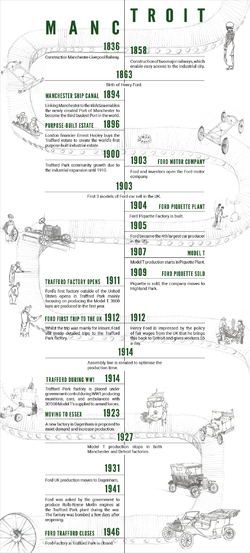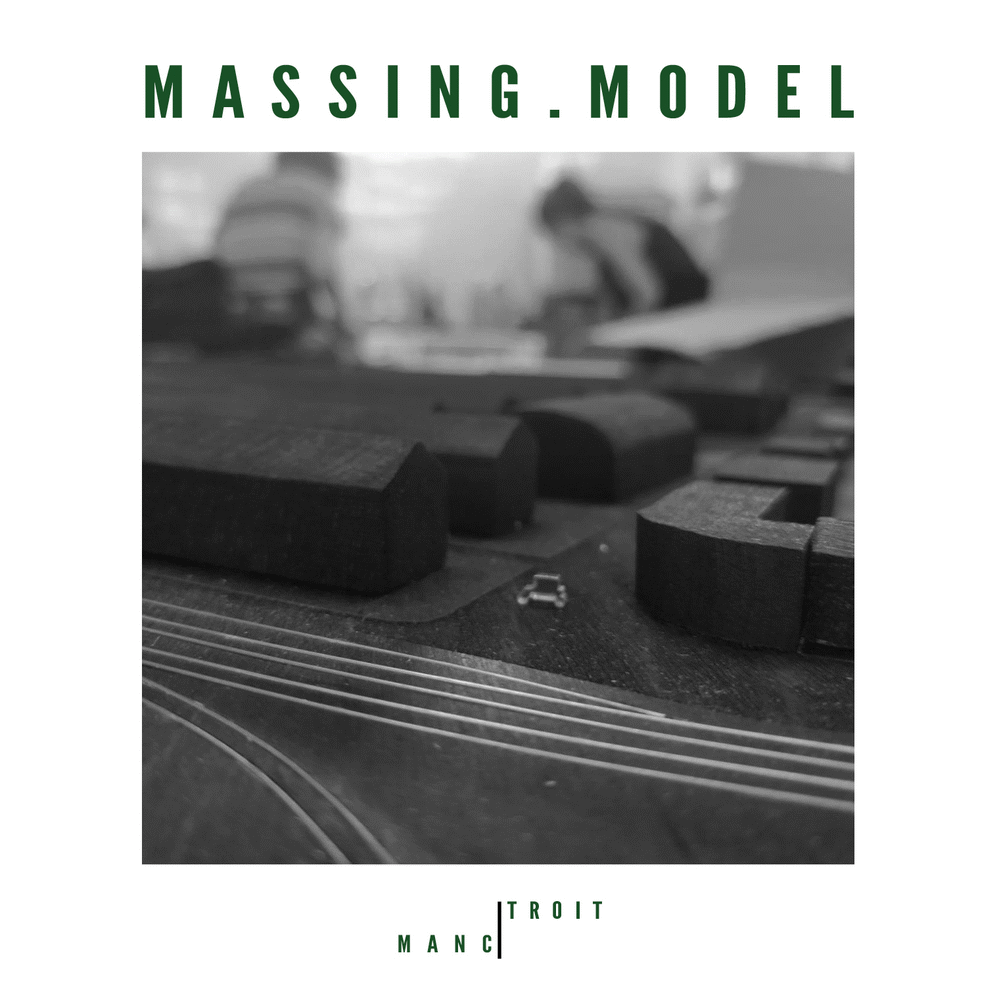
DAY 9
Here an example of how we decided to address our collaborator's request of how a model can tell a story. In fact, by integrating different types of information in the model we produced a display to combine all our materials together. To provide an added value to our output, we designed the possibility of being interactive by using postcards deepening the content of both sides of the timeline.
1904 | TROIT
"THE ORIGINS OF THE FORD PIQUETTE PLANT
The Ford Piquette Plant was Henry Ford’s first car production factory, it oversaw the production of Ford models B, C, F, K, N, R, S, and T during its service. The building was a total of 3.11 acres, covering an entire city block and was located strategically next to the Michigan Central Railroad. It consisted of three storeys: the ground floor housed a machine shop, the shipping department and was used to test cars; the first floor was focused on assembly and storage; and the second, oversaw drafting, and final assembly of all vehicles. The Ford Motor Company’s presence in the plant ended in 1910 as it moved to the larger Highland Park Plant, selling the Piquette to automobile manufacturer, Studebaker in
1911."
Posted 4 Apr 2019 15:13
DAY 9
Today we met to organise the last steps to finalise our output. We first printed out the materials prepared during this workshop to show our idea of integrating information within a physical model. Once we got the prints, we brought the timeline and the 10 postcards to B.15 to finally combine them with the architectural maquettes. As established, our final output is going to be a combination of different type of information in order to deepen the stories that our models are telling about the Ford Factories as the main industrial connection between Manchester and Detroit.
Posted 4 Apr 2019 14:57
DAY 8
This morning the MANC|TROIT group finished the timeline of Ford Factory in both cities. Using InDesign we combined all the significant dates to represent Henry Ford and his company journey by comparing the events in our cities. Moreover, we integrated in the layout the concept of the assembly line production, that Ford introduced in his factories in 1914. In fact, the background of the timeline is showing different steps of the Model T production through some sketches made by all participants.
Posted 4 Apr 2019 14:08
DAY 7
We were asked by our collaborator Katie Belshaw, curator of the Science + Industry Museum in Manchester, to research how a model can tell a story. Following the brief of our collaborator, today we worked on the layout of the display to integrate models with the research. The models demonstrate the formal and spatial configurations of the Ford Factory in the two cities: Manchester and Detroit. However our background research outlines the socio historical background. Of our final output is a display that integrates those elements through models, sketch analysis, postcards combined into a timeline.
Posted 2 Apr 2019 12:50
DAY 5
Some of the details of Ford Factory massing model in Trafford Park. The choice of using black for our models is related to the history of the production of the Model T. In fact, when the Model T first came on the market, customers could get different colour, except for black. The first black Model T became part of the assembly line five years later, and this started a decade of monochromatic Model T’s all over the world. According to some, Henry Ford switched to black paint because it dried faster, and this suggests a consequence on the efficiency of the production: drying faster allowed to sell more car in less time. Also, black paint was cheap and durable.
Posted 1 Apr 2019 14:55
DAY 5
While carrying on with the research about Ford Factory to understand why Henry Ford came to Manchester, part of the EVENTS19 Group N were in B.15 workshop for developing the model.
The model of Ford Factory in Trafford Park, Manchester, will be a massing model 1:500 to show the relationship between the mass of the factory and the small volumes of the residential buildings around. Also, within this model we are going to show the importance of the infrastructure in the site: ship canal, railway and streets. We think that these significant elements of urbanisation are part of the reasons why Henry Ford chose this area for the production of his Model T car.
Posted 1 Apr 2019 14:28
MANC | FIELD TRIP
DAY 2
Today we went to visit Trafford Park to understand the industrial heritage of Manchester and the relationship of these buildings with urban form. Moreover, Trafford Park visit help us understanding the background of the Ford Factory in Manchester. Our research starts with finding the reason why Henry Ford came to Manchester from Detroit, and why he decided to participate to the first purpose-built industrial heritage in the world.
Posted 26 Mar 2019 16:24
MANC | FIELD TRIP
26.03.2019
The aim of the visit of the Science and Industry museum is to learn about the importance of Manchester in the development of technology and industry. Whereas the visit of Trafford Park will help us to understand the industrial heritage of Manchester.
Field trip itinerary:
_10:00 am
Meet at main entrance to Science and Industry Museum
Liverpool Road - Manchester M3 4FP
_1:00 pm - 2:00 pm
LUNCH BREAK (If you would like to travel with us meet back at 2.00pm)
_2:30 pm - 5:00 pm
Walk around Trafford park
Deansgate - Castlefield Metrolink Service to Traffrod Bar
At Trafford bar please take Bus 250 to Village Circle
Advice for all participants:
We should pay attention to the models used in the existing exhibitions and analyse through sketches to help us define our strategy for the model making. It would be useful to take photographs of both these experiences in order to start the research of MANC|TROIT events.
Bring sketch books and cameras.
Posted 25 Mar 2019 18:23
DAY 1
Events started this morning with an introduction to the brief and the timetable. MArch students presented the connections between Manchester and Detroit, as both industrial cities, and their relationships with the Ford Factory.
Group N discussed the contents of the workshop and defined the outputs of this Events: 2 models representing the Ford Factory both in Manchester and in Detroit, and the best way to represent their formal and spatial features. According to this, the Ford Factory in Trafford park will be represented with a massing model to understand its volumetric relationship with the residential context, as a first purpose-built industrial estate in the world. Whereas for the Ford Piquette Plant in Detroit the model will be in a bigger scale, to show the architectural details of this building.
Posted 25 Mar 2019 11:25
We are going to focus on the connections between Manchester and Detroit, and their industrial backgrounds.
In the first week, after two field trips, the workshop will research and define how to represent these links throughout model making.
During the second week, students and coordinators will work alongside to actively use the maquette to create a storytelling able to communicate the MANC|TROIT industrial connections.
+ At the end of the workshop, we will present the final output to our collaborators: Katherine Belshaw, curator of the Science + Industry Museum, and Dominic Sagar, MSA lecturer.
Posted 27 Feb 2019 20:18
Introducing MANC | TROIT team
Celeste | Serena
Posted 31 Jan 2019 14:29
Introducing MANC | TROIT team
Caterina | Karolina
Posted 31 Jan 2019 14:29
Introducing MANC | TROIT team
Hanna | Daniel
Posted 31 Jan 2019 14:28












